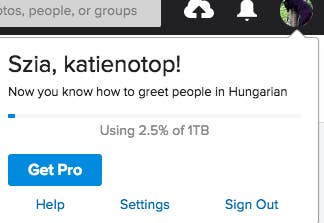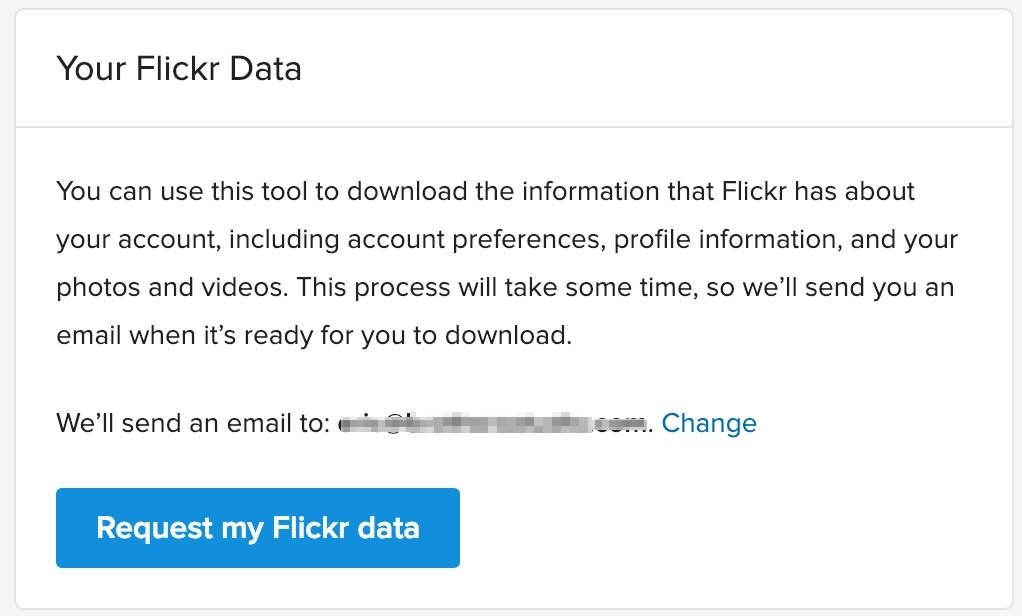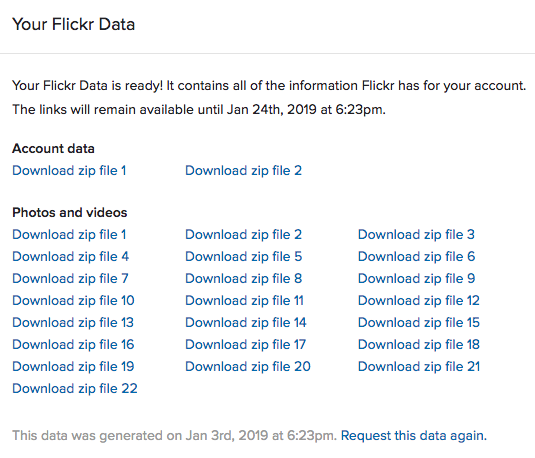
If you have over 1,000 photos on the image-hosting site Flickr, this is VERY IMPORTANT. You need to download those photos NOW, or they will be DELETED. Yes, that sucks. It sucks a lot! You don’t want to lose your photos, so pull up your big boy pants and actually log in to Flickr and take care of this TODAY. I AM YELLING AT YOU RIGHT NOW! DO IT!
Here’s the rundown: In April 2018, Yahoo sold Flickr to a company called SmugMug, which has been around a long time, mainly as a professional photographers site. All was well and fine, at first.
Then, in November, SmugMug-owned Flickr announced that it planned to end the free unlimited image storage the site offered users, starting Jan. 8 (that’s today, bitches). From now on, Flickr will only host 1,000 photos for free, and if you have more than that uploaded to the site, it will stop displaying them. You also won’t be able to upload any more photos to your account if you’ve hit that 1,000 limit.
As of today, you have two options: Keep your photos up and pay for a Pro account ($50/year).
Or, download them and be on your merry way, to do whatever you want to do with those weird photos you had on there in 2009. Unfortunately, if you had meticulously organized your photos on Flickr with albums and sets, all that organization will be lost. You’ll just get your photo files and some basically meaningless .json files with metadata.
For the next few weeks, Flickr won’t delete your extra photos, but it will hide them. But starting Feb. 5: IT WILL DELETE YOUR PHOTOS!!!!! Starting with the oldest photos, it will purge them from the site, and you won’t be able to recover them.
Here’s how to download your photos from Flickr:
First, log in. Yes, I know you may have forgotten your old Yahoo login, but bite the bullet and do the password reset.
Go into your user account > Settings.

At the bottom of this page, you’ll see an option to “Request my Flickr data.” Change the email address if it’s an old one you don’t use!!!!

It takes a little while, but you’ll get an email with a link. That will take you to a page where you can download zip files of your old photos. Depending on how many photos you had on there, you might get many or only a few zip files. I had about 10,000 photos and I ended up with 21 zip files.

Now that you have your photos downloaded from Flickr…what next?
You have a few options, and they’re not great (nor 100% free, sorry).
Cloud storage.
Google Photos is probably the easiest cloud storage to add them to, especially if you already have Google Photos because you use Android or other Google products, like Gmail. It’s free up to 15GB. But if you’re using it for all your photos, you’ll probably need to pay for more storage, starting at $1.99/month. Be aware that depending on the amount of storage you have, you may not be able to save your photos at full resolution. Also, owners of the original Pixel 1 and XL phones get free unlimited photo storage for life, so if that’s you, it’s a no-brainer.
If you’re an iPhone person and already pay for iCloud, go for that if it’s easier. Amazon Prime members also get 5GB of free photo storage. The Verge has a good article to help you pick the best cloud storage option.
And lastly, since you’re probably going to have to pay for cloud storage at some point, you may actually want to just pay for Flickr Pro if you love the Flickr features.
Put them on an external hard drive.
Pro: They’re safe! Con: They’re locked on a hard drive, never to be seen again. If you already have an external hard drive you use for backups of your computer and other photos and files, you’re already ahead of the game — kudos to you. If you don’t, consider getting one. BuzzFeed Reviews recommends one that’s about $75, but you can get a smaller (160GB) one for around $20–$25.
KonMari them.
Follow the advice from Netflix’s weird new hit show Tidying Up With Marie Kondo, in which a Japanese lifestyle guru helps people declutter their homes. Her advice for photos is to sort through and actually throw out the bad pics and doubles, and just keep the best ones. With digital photos, this makes less sense since they’re not actually taking up physical space, but at some point, you might realize all your digital photos from the last decade are leaving a messy trail around your life. Perhaps you don’t need all the blurry extra shots from that college party.
Print them and actually look at them.
There are a ton of photo printing services, and they’re all cheaper than you might expect (way cheaper than printing real film). Costco has good prices (if you have a membership, it starts at $0.17/print); my mother-in-law is a Shutterfly devotee ($0.15/print, but they always have coupons); I’ve used Snapfish ($0.09/print). They’re all around the same quality, and prices vary a little based on constantly changing coupons. Make a photo album! Give a print to a friend!
We shouldn’t trust a company to store our photos for free for eternity, but it’s hard to learn that lesson a few years too late.
What’s sad is that lots of people won’t actually download their photos from Flickr before they’re gone forever. Maybe they won’t check the email address the notification was sent to; maybe they won’t be able to log in; maybe they won’t remember they had the account at all. And even if everyone actually DOES save their old photos, they’d just live on their hard drives, rather than being shared with the world. Flickr was a wonderful part of the mid- to late-00s internet that had a real community.
Of all our data scattered across the internet, photos are the most tangible and personal, something that feels like true a loss when they disappear. This isn’t the first time a photo site deleted old user photos. In 2012, Webshots, a short-lived site popular in the mid-00s, went out of business and nuked old photos. In 2017, Photobucket ended its free storage for hotlinking — which effectively broke bajillions of links to images hosted on there that were posted on blogs, websites, and forums across the internet. Just this fall, Yahoo-owned Tumblr banned old adult content, wiping out a massive chunk of internet culture.
It’s all a good lesson about how we shouldn’t trust a company to store our photos for free for eternity, but it’s hard to learn that lesson a few years too late. We have to stay vigilant about our digital property — OUR photos, OUR data — if we want to hold onto it. Which is why I’m nagging you: DOWNLOAD YOUR DAMN PHOTOS NOW!
